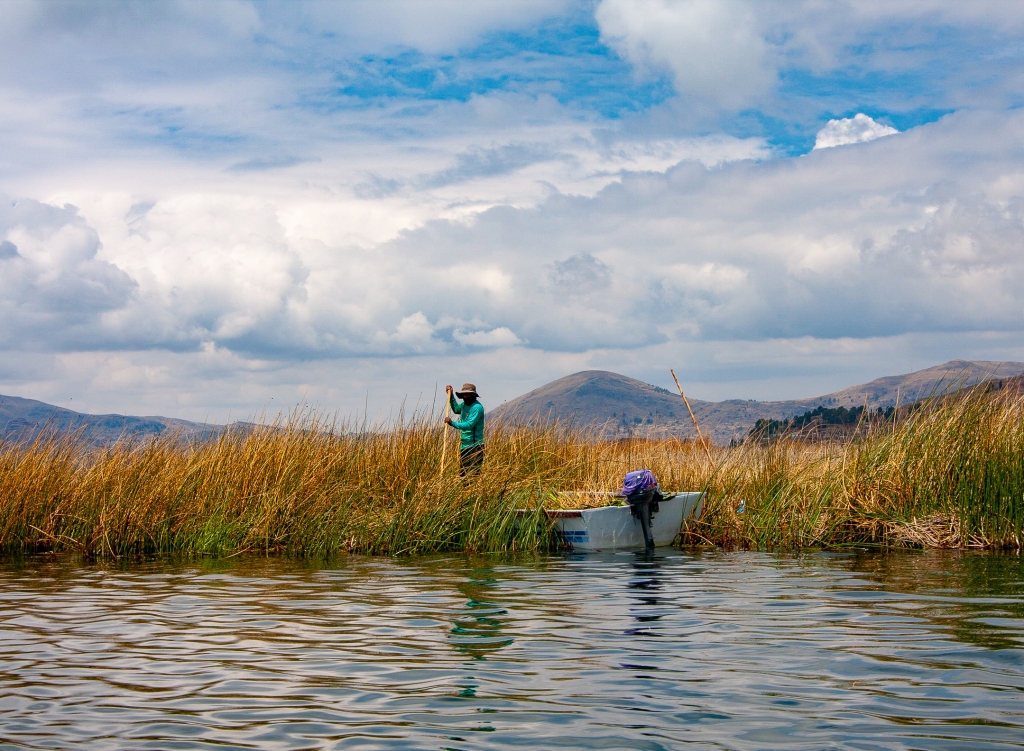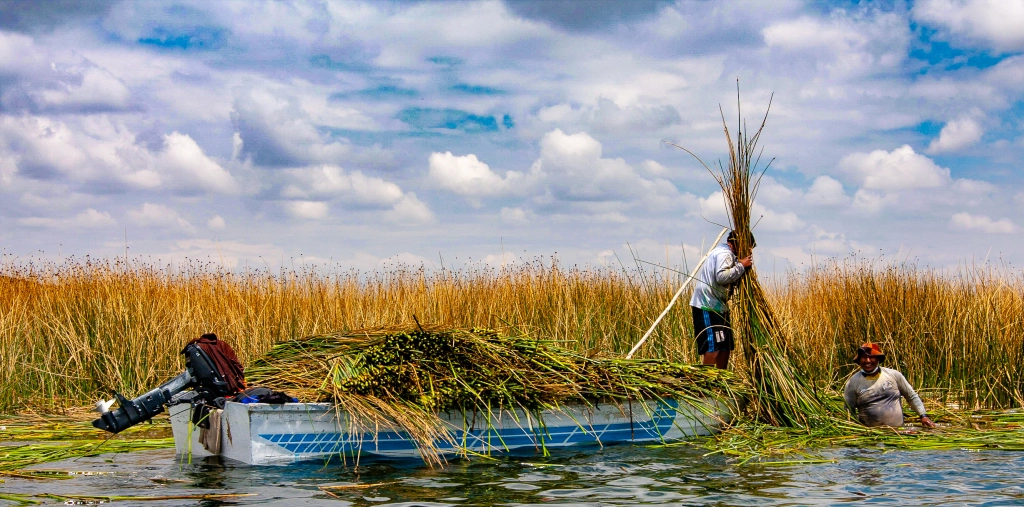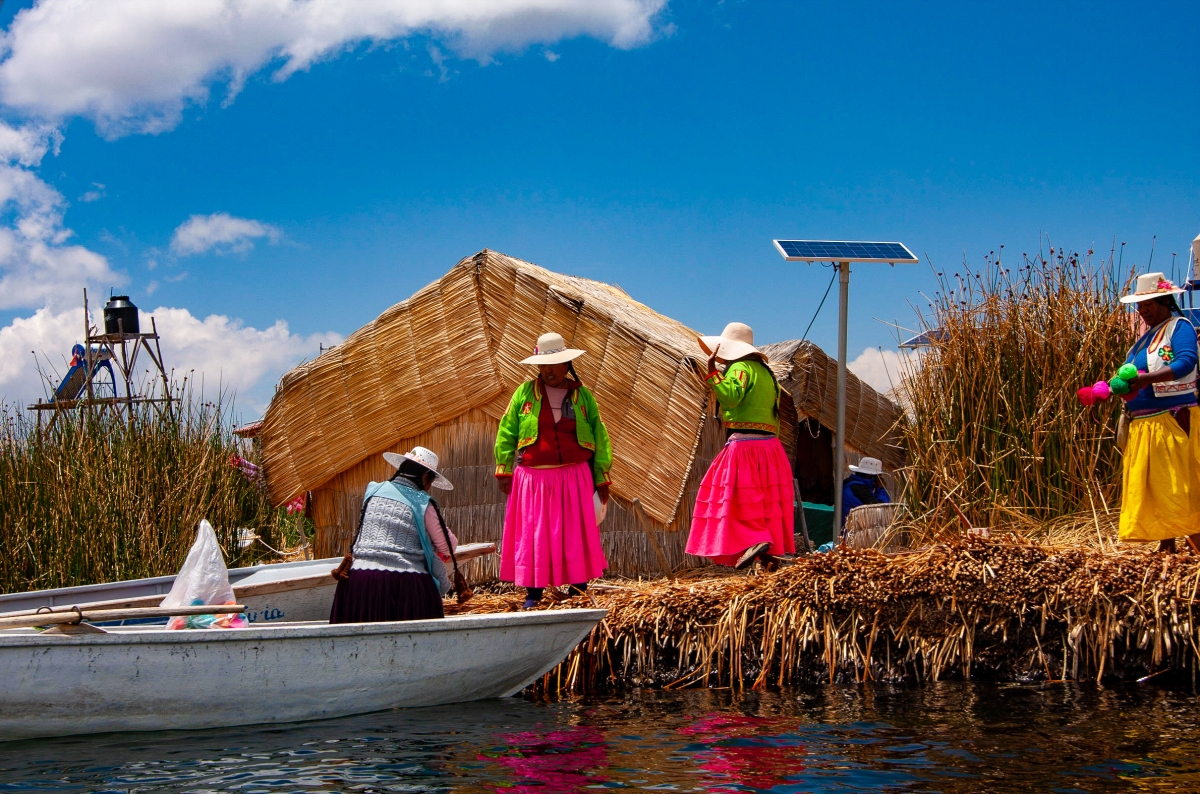Julio Suana Coila is an amazing man. But if it weren’t for Julio’s perseverance, his love for his wife, and a little luck, I would never have met him.
Julio is from the Uros community on Lake Titicaca in Peru. His native language is Quechua, but he also speaks some Aymara–the language of his parents–as well as Spanish and English. Years ago, Julio saw opportunity in bringing tourists to his community, so he decided to enter a tourism program at the university in Puno. This decision required him to travel by boat each day from his floating island on Lake Titicaca, but it gave him the credentials and confidence he needed to start a new business for himself, his family, and his community.
The Uros community is situated on the Peruvian side of Lake Titicaca near the city of Puno. Considered the highest navigable lake in the world, Titicaca sits at 12,507 feet above sea level. After moving onto floating islands made out of the lake’s reeds (totora) to escape the expanding Incan empire about 500 years ago, the community has survived Incan expansion, Spaniards, the establishment of Peru and Bolivia as independent nations, and modernity. The 2,000-some remaining descendants maintain their lake-based community, complete with solar panels, an elementary school, and radio station. Situated only about 10-15 minutes from shore by boat, the community is also reachable for day trips, as well as overnight stays at multiple lodges built and managed by several resident families.

My wife and I had the privilege of staying at Julio’s Titicaca Lodge Peru for two nights in October of 2021. Julio began constructing his island about 20 years ago. In the meantime, he studied tourism at the university in Puno, learned English, and got married. The lodge has three individual rooms with large lake-fronting windows, king beds, showers, dry toilets, lounging areas, a large vanity sink, and alcohol-fueled heater. Each lodge also has an outside lounging area. In addition, there’s a separate dining room where Julio serves three meals a day prepared by his lovely wife.

Aside from the opportunity to relax and be separated from the rest of the world, we had the opportunity for Julio to take us on a tour of the community where he told us all about the history of the Uros people, the challenges faced by the community over the years, the move towards tourism as the community’s life-blood, and the severe problems wrought by the COVID-19 pandemic.
According to Julio, about 20 families made the decision 5-6 years ago to invest in building overnight lodges on their islands. This would allow them to tap into the tourism market more than day trips allow, and create greater income potential beyond selling handmade goods. Their plan was working well until COVID put a halt to tourism in Peru.
Now, only about 30% of the community’s residents remain, with the majority deciding to seek opportunity on the mainland not dependent on tourism. This is an undeniably sad development, but it also carries severe ramifications for the survival of the community itself. As the floating islands are made out of reeds and exposed to the elements, they must be continually maintained. If an islands’ residents leave, without someone to maintain it by periodically refreshing the top layer of reeds the island will eventually rot and return to the lake bottom.

I don’t know what the answers are for the continued survival and success of the Uros people, but I know that it was an honor to visit them and enjoy their company. I can’t say enough about how special this experience was, and I highly recommend anyone with a sense of adventure and looking to unplug from their routine to go and stay at Julio’s.

Getting there: Unless you’re coming from Bolivia, you’re likely to access the Peruvian side of Lake Titicaca by flying into Juliaca. There are multiple daily flights from Lima (and pre-COVID there were flights from Cusco) into the tiny Juliaca airport. Because of its smallness, it’s probably wisest to arrange a driver with wherever you’re planning to stay before arriving. If you’re heading to the Uros floating islands, it’s an hour drive to the lakefront boat launch in Puno.
Word to the wise: if you haven’t already acclimated to higher altitudes by spending some time in Cusco and the Sacred Valley, you might have a rough first couple of days here. I’d recommend not going to the lake straight from Lima.
When flying out of Juliaca, don’t bother getting to the airport too early. The airline check-in desks only opened 1-1.5 hours prior to departure, which meant you only had one small cafe to wait in prior to being allowed in the terminal, but once in, there is surprisingly a Priority Pass lounge.
This is part three of my four-part series of our 2021 South American trip. You can also read about our experiences in Bogota and Machu Picchu.


